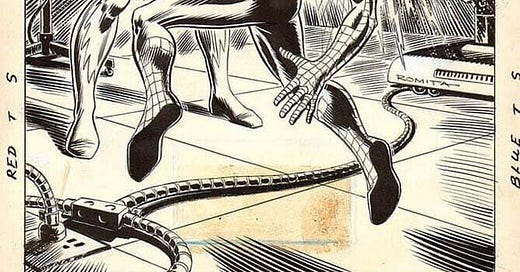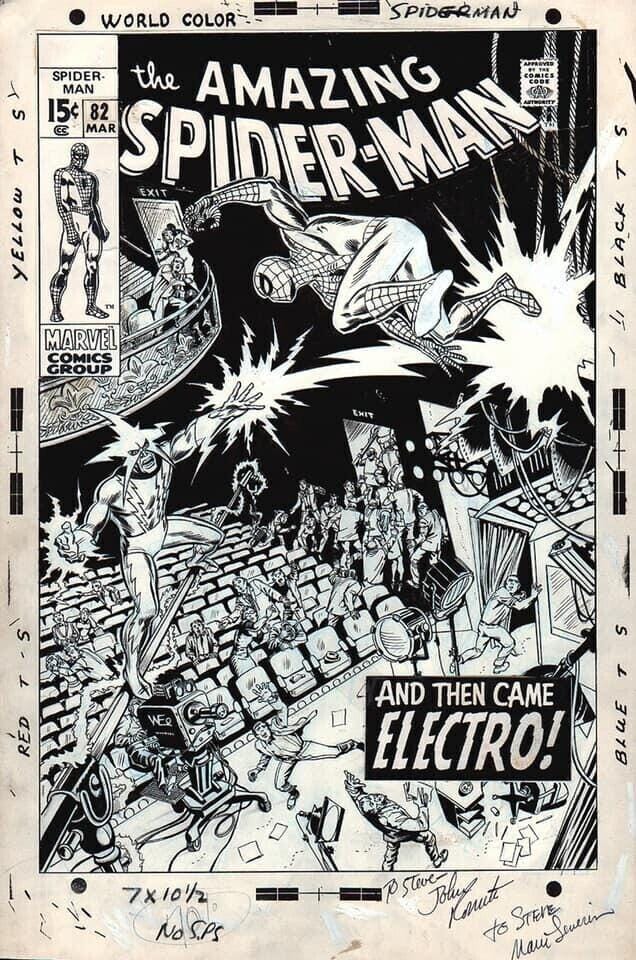Your Comic Cover - Your Most Valuable Sales Tool
Catch your readers from the get go, then don't let them go!
Comic artist Michael Neno recently shared John Romita's rejected cover for Amazing Spider-Man #82, and Marvel’s published cover by Marie Severin, who was assigned to redraw it. (John Romita inked the main figures on the Severin cover).
I can guess why the cover was redrawn, presumably at the direction of editor Stan Lee. As an attention grabber, there’s not enough action in the original, despite the drama it portrays and the quality of the art. The published cover is far more eye catching, and a stronger sales tool, following basic principles of comic cover design vital to hopefully attracting stronger sales.
During my first job as a magazine editor, at Marvel UK, my old boss Sheila Cranna was the first to drum into me the importance of the inverted to the inverted “L” when it came to cover design, since you’d be lucky to have your full cover on display in a newsagent’s. Richard Starkings was another. I’m grateful to them both for their wisdom.
Essentially, this means that anything important in terms of cover lines, or a promotional cover mount, or a major competition, would generally be placed on the left hand side of a cover, and you’d make the most of your cover lines above the masthead, too. The same goes for trying to convey content in terms of your cover art, and it’s been noted elsewhere that before the advent of the spinner rack in US stores, the top third of a cover is where all the visual interest needed to be, in order to catch the eye at the newsstand.
I don’t know when spinner racks were first introduced into US stores, and although there’s plenty of discussion of them online, I can’t find a date, even on Wikipedia. But while I’m fairly certain it was before this Marvel cover made its debut in 1970, on a lot of traditional displays, you wouldn't even see Spider-Man on that first cover at all.
Dez Skinn, who edited Doctor Who Weekly and countless Marvel UK superhero comics, and WARRIOR, rightfully opines that your cover needs to catch the eye from across the room. “Movement”, as featured in the published cover, is one way to achieve this. It’s very useful advice.
For me, discussion of this cover also highlights the importance of the “ident box” for Marvel Comics, almost a mini cover within a cover, and one it’s clear some artists, like John Byrne during his run on Fantastic Four, was determined to have fun with.
These subtleties may be lost on the comics buyer, in much the same way that some undervalue the importance of some elements of quality comics making, like good lettering, which escaped one Facebook commentator I recently had the misfortune to have dealings with. But cover design is hugely important to attracting higher sales, and if you’re a comic creator who’s agonised over it in the past, you are very definitely not alone, and only your best will do, if you want your title to sell.
I can’t pretend I’ve always got it right, but I at least had the very best advice to inform my choices. Good luck on the stands!
John Freeman
Online at www.downthetubes.net
PS I’m delighted to confirm that I’ll be attending the Lakes International Comic Art Festival next month (15th - 17th October), in Kendal. I’ll be centring my activities on the B7 Media stand in the free-to-enter Comic Clock Tower, where copies of SHIFT magazine Issue 8 will be on sale, which includes a promotional preview of B7 Comics Pilgrim drawn by Wam Nick, coloured by Martin Baines, lettered by Robin Jones, a trailer for a new four-issue SF story I’m writing, to be drawn by X-Men artist Neil Edwards, with a great cover by Alex Ronald. See you there?
Amazing Spider-Man covers © Marvel Comics | Fantastic Four idents © Marvel Comics









Just as an addendum to this post, I’ve just discovered John Romita's rejected cover for Amazing Spider-Man #82 was used, eventually, as the cover for the reprint title, Marvel Tales #63, released in 1975. The background is knocked back and the scene “told” through dialogue. Check it out on that great resource, Cover Browser https://www.coverbrowser.com/covers/marvel-tales/2